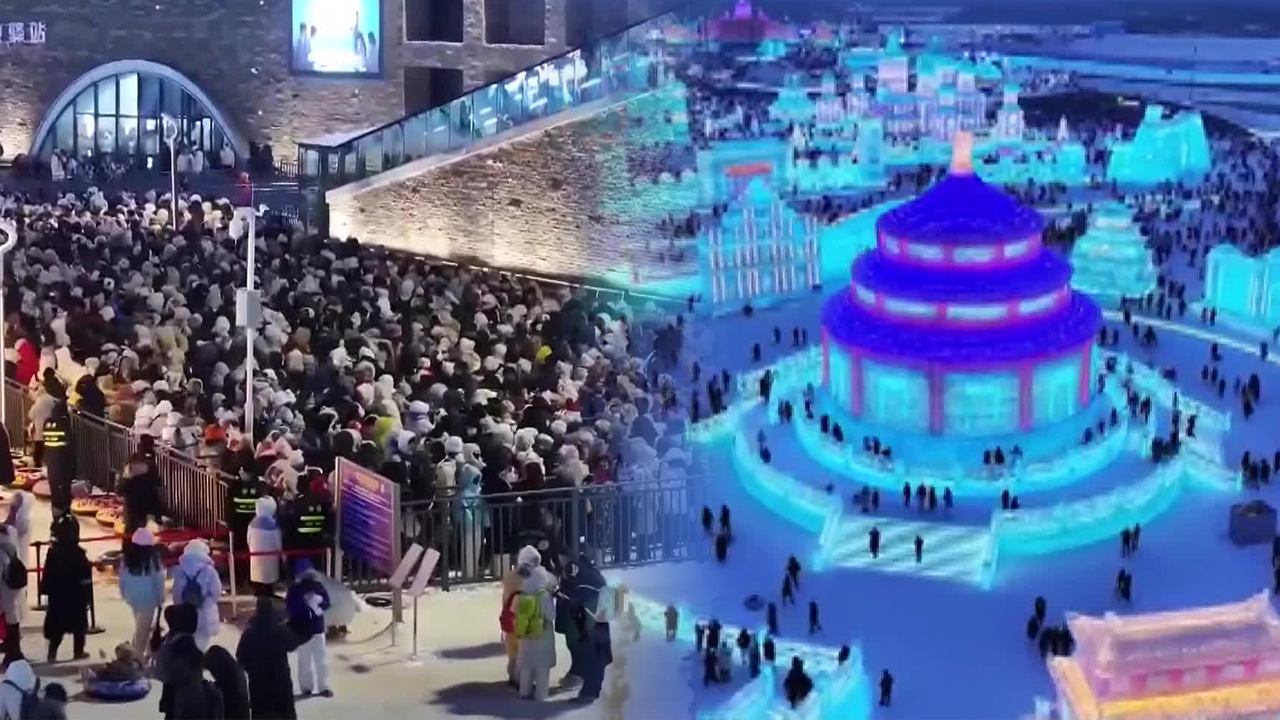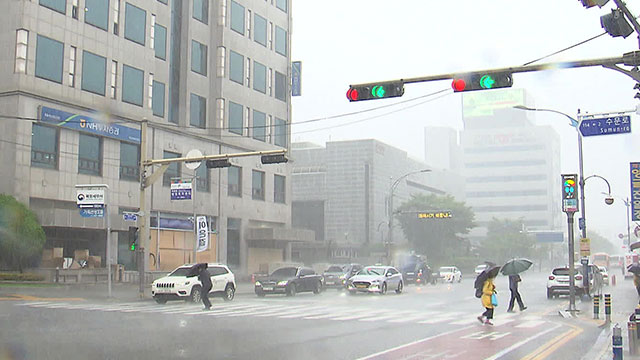China boosts ice and snow economy with winter festivals
입력 2024.12.25 (23:25)
읽어주기 기능은 크롬기반의
브라우저에서만 사용하실 수 있습니다.
[Anchor]
The winter festival has opened in Harbin, China, known for its extreme cold.
A large crowd has gathered, enjoying a tourism boom.
Chinese authorities and media are also boosting the atmosphere, working to revitalize the domestic economy through winter festivals and other events.
This is Kim Min-jung reporting from Beijing.
[Report]
Brilliant beams of light shine around the massive ice sculptures.
Ice sculptures modeled after famous Chinese buildings capture the attention of tourists.
[Harbin Tourist: "It's truly amazing. It's incredible that so much ice can create such beautiful sculptures in one place."]
They brought 300 million liters of snow and ice to create sculptures on the largest site ever, about the size of 140 soccer fields.
As the crowd became so large that people had to wait nearly 7 hours just to ride one ice slide, exhausted tourists began to shout for refunds.
["Refund! Refund!"]
Thanks to the popularity of the ice festival, hotel bookings in Harbin have increased by 73% compared to the same time last year.
The price of airline tickets to and from Harbin has also risen by 46% compared to last month.
Chinese media are praising Harbin as a model case, promoting the so-called 'ice and snow economy.'
Through winter festivals and sports, they aim to attract young tourists to spend money and boost economic vitality.
[Chinese CCTV Report: "Interest in winter sports and tourism drives economic growth, unleashing the potential of the 'ice and snow economy.'"]
The 'ice and snow economy' also signifies fostering new industries in the relatively underdeveloped northeastern region of China.
This is a strategy by Chinese authorities to overcome economic recession by increasing domestic consumption.
This is Kim Min-jung from KBS News in Beijing.
The winter festival has opened in Harbin, China, known for its extreme cold.
A large crowd has gathered, enjoying a tourism boom.
Chinese authorities and media are also boosting the atmosphere, working to revitalize the domestic economy through winter festivals and other events.
This is Kim Min-jung reporting from Beijing.
[Report]
Brilliant beams of light shine around the massive ice sculptures.
Ice sculptures modeled after famous Chinese buildings capture the attention of tourists.
[Harbin Tourist: "It's truly amazing. It's incredible that so much ice can create such beautiful sculptures in one place."]
They brought 300 million liters of snow and ice to create sculptures on the largest site ever, about the size of 140 soccer fields.
As the crowd became so large that people had to wait nearly 7 hours just to ride one ice slide, exhausted tourists began to shout for refunds.
["Refund! Refund!"]
Thanks to the popularity of the ice festival, hotel bookings in Harbin have increased by 73% compared to the same time last year.
The price of airline tickets to and from Harbin has also risen by 46% compared to last month.
Chinese media are praising Harbin as a model case, promoting the so-called 'ice and snow economy.'
Through winter festivals and sports, they aim to attract young tourists to spend money and boost economic vitality.
[Chinese CCTV Report: "Interest in winter sports and tourism drives economic growth, unleashing the potential of the 'ice and snow economy.'"]
The 'ice and snow economy' also signifies fostering new industries in the relatively underdeveloped northeastern region of China.
This is a strategy by Chinese authorities to overcome economic recession by increasing domestic consumption.
This is Kim Min-jung from KBS News in Beijing.
■ 제보하기
▷ 카카오톡 : 'KBS제보' 검색, 채널 추가
▷ 전화 : 02-781-1234, 4444
▷ 이메일 : kbs1234@kbs.co.kr
▷ 유튜브, 네이버, 카카오에서도 KBS뉴스를 구독해주세요!
- China boosts ice and snow economy with winter festivals
-
- 입력 2024-12-25 23:25:18

[Anchor]
The winter festival has opened in Harbin, China, known for its extreme cold.
A large crowd has gathered, enjoying a tourism boom.
Chinese authorities and media are also boosting the atmosphere, working to revitalize the domestic economy through winter festivals and other events.
This is Kim Min-jung reporting from Beijing.
[Report]
Brilliant beams of light shine around the massive ice sculptures.
Ice sculptures modeled after famous Chinese buildings capture the attention of tourists.
[Harbin Tourist: "It's truly amazing. It's incredible that so much ice can create such beautiful sculptures in one place."]
They brought 300 million liters of snow and ice to create sculptures on the largest site ever, about the size of 140 soccer fields.
As the crowd became so large that people had to wait nearly 7 hours just to ride one ice slide, exhausted tourists began to shout for refunds.
["Refund! Refund!"]
Thanks to the popularity of the ice festival, hotel bookings in Harbin have increased by 73% compared to the same time last year.
The price of airline tickets to and from Harbin has also risen by 46% compared to last month.
Chinese media are praising Harbin as a model case, promoting the so-called 'ice and snow economy.'
Through winter festivals and sports, they aim to attract young tourists to spend money and boost economic vitality.
[Chinese CCTV Report: "Interest in winter sports and tourism drives economic growth, unleashing the potential of the 'ice and snow economy.'"]
The 'ice and snow economy' also signifies fostering new industries in the relatively underdeveloped northeastern region of China.
This is a strategy by Chinese authorities to overcome economic recession by increasing domestic consumption.
This is Kim Min-jung from KBS News in Beijing.
The winter festival has opened in Harbin, China, known for its extreme cold.
A large crowd has gathered, enjoying a tourism boom.
Chinese authorities and media are also boosting the atmosphere, working to revitalize the domestic economy through winter festivals and other events.
This is Kim Min-jung reporting from Beijing.
[Report]
Brilliant beams of light shine around the massive ice sculptures.
Ice sculptures modeled after famous Chinese buildings capture the attention of tourists.
[Harbin Tourist: "It's truly amazing. It's incredible that so much ice can create such beautiful sculptures in one place."]
They brought 300 million liters of snow and ice to create sculptures on the largest site ever, about the size of 140 soccer fields.
As the crowd became so large that people had to wait nearly 7 hours just to ride one ice slide, exhausted tourists began to shout for refunds.
["Refund! Refund!"]
Thanks to the popularity of the ice festival, hotel bookings in Harbin have increased by 73% compared to the same time last year.
The price of airline tickets to and from Harbin has also risen by 46% compared to last month.
Chinese media are praising Harbin as a model case, promoting the so-called 'ice and snow economy.'
Through winter festivals and sports, they aim to attract young tourists to spend money and boost economic vitality.
[Chinese CCTV Report: "Interest in winter sports and tourism drives economic growth, unleashing the potential of the 'ice and snow economy.'"]
The 'ice and snow economy' also signifies fostering new industries in the relatively underdeveloped northeastern region of China.
This is a strategy by Chinese authorities to overcome economic recession by increasing domestic consumption.
This is Kim Min-jung from KBS News in Beijing.
-
-

김민정 기자 mjnews@kbs.co.kr
김민정 기자의 기사 모음
-
이 기사가 좋으셨다면
-
좋아요
0
-
응원해요
0
-
후속 원해요
0











![[단독] 위성락 실장 “전작권 협상 카드 아냐”…차관 인선 발표](/data/layer/904/2025/07/20250713_krfuHu.jpg)



이 기사에 대한 의견을 남겨주세요.